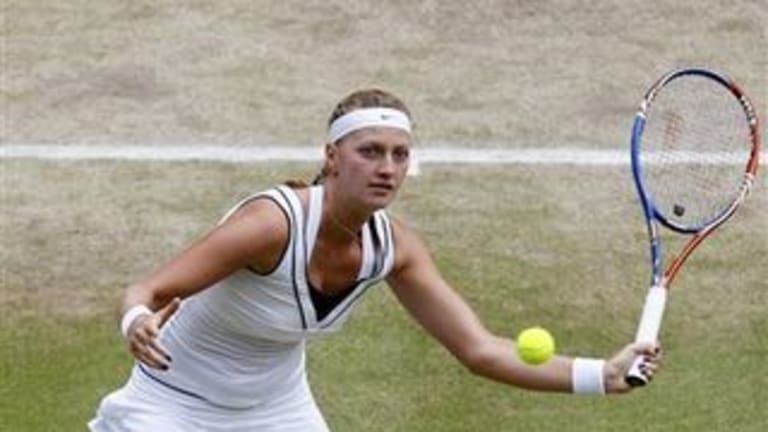by Pete Bodo
LONDON—Petra Kvitova was about to toss the ball to serve at 3-1, 40-love in the fifth game of the first set today at Wimbledon when an alarm went off in Centre Court, causing her to pull up momentarily. Both the source of and reason for the siren remain unknown, but I have my own theory. The hoary heads at the All England Club had determined that Kvitova's serve is so menacing a weapon that both her opponents and the public need to be alerted, much like they would be during an air raid. This, sadly, is a subject with which elderly British citizens who lived through the Blitz of World War II are more than familiar.
The interruption was relatively brief and completely ineffective, at least in terms of making Azarenka's life easier or safer. Kvitova immediately went back to the business at hand and blasted her way to a 6-1 first-set win. Azarenka won the second set, but Kvitova was able to notch a service break in the second game of the third set, and won the match on the strength of it, 6-1, 3-6, 6-2. It was a tightly scripted, orderly match; a testament to the idea that the advantage of serving ought to impose a satisfying sense of structure on a match, particularly one on a grass court.
"I think she started, you know, serving, and she really played very well on her service game," Azarenka conceded afterwards. "It was a little bit of a bad luck. . . I just miss just couple (in the third set), and she really took great advantage of it."
If you didn't know better, you might have plopped down on Centre Court and wondered if Azarenka and Kvitova weren't the WTA version of the Bryan twins, warming each other up for a doubles match. The young ladies had identical hairdos—the almost obligatory French braid—and similar, pristine white samurai headbands. They were both attired in chaste white. Anyone less than eagle-eyed was more likely to tell them apart by which hand they used to serve, or better yet, what we might call their auditory signatures.
Azarenka accompanies nearly every shot with a prolonged shriek of something like ecstacy. While largely silent, Kvitova will react to winning a particularly important point with a terrified shriek—you expect her to leap up on a stool, as if she'd just spotted a mouse. My pal Doug Robson of USA Today, who really ought to apply his imagination to more useful things, suggests that Kvitova sounds like a pterodactyl giving birth.
Oddly, though, Kvitova is largely silent during play. Today, she appeared to be making a strenuous effort to remain calm and in control of the situation—just what you might expect from a 21-year-old trying to surmount the semifinal barrier for the first time at a Grand Slam event, and this the most renowned of them all, as well as the one most favorable to her game and technical assets. In fact, if there was a danger in her approach, it probably lay less in getting careless than in becoming tied up in one too many knots. The silence was misleading, for at almost every critical moment she subtly clenched a fist or went into a momentary spasm, whirling to glance at the player guest box.
A player in that state is always prone to relax, even if it's inadvertently, after she wins a set—and so it was today. After losing the first set, Azarenka bolted to a 3-0 lead in the second and had two more break points with Kvitova serving at 1-4. Had Azarenka converted one of them, it might have opened floodgates. But Kvitova held fast, thereby buying time to get her game—and composure—back on track.
Kvitova's first-serve conversion rate was merely good (60%), but she won 73% of her successful first-serve points. More important, her serve kept Azarenka, an aggressive if somewhat one-dimensional baseliner, back on her heels. Azarenka had a chance to level the match in the third with Kvitova serving at 3-1, 15-40. Kvitova dismissed the first break point with a bold attack and forehand volley winner, and the other with an inside-out forehand winner. A deadly second serve to the Azarenka backhand at deuce, followed by a wide-swinging sliced ace, secured the game—and foiled Azarenka's last threat. The thread that ran through the entire match was the effectiveness of Kvitova's serve.
"Well, yeah, I think it's about I have a good serve," Kvitova said afterward. "And I'm not afraid of going to volley because we practiced with my father when I was young."
It isn't really the speed of Kvitova's serve that bowls anyone over. Even in an overpowering performance of the kind that Kvitova turned in earlier in the tournament against Yanina Wickmayer (Kvitova crushed her, 6-0, 6-2), she rarely tickles the speed gun much past 110 MPH, where some others (Sabine Lisicki comes to mind) are routinely breaking the 120 mph barrier. Rather, it's that Kvitova fully exploits the formidable combination of her height (6' 0"), reach, and left-handed-ness—perhaps more than comparable WTA pros, or even many of the ATP southpaws.
The key serve for Kvitova is that ad-court, wide-swinging slice. It's a devastating serve, easily differentiated from the standard cannonballs, kickers and even right-or-left-handed slices. That serve almost belongs in a category of its own, because of the slightly different rotational demands it puts on the server's shoulders. John McEnroe sliced his way into the International Tennis Hall of Fame with that serve, and Feliciano Lopez has it; Rafael Nadal doesn't exploit it, and Martina Navratilova never really developed her heavy swinger either.

